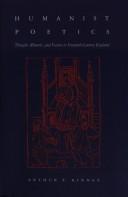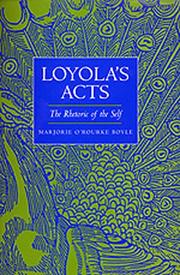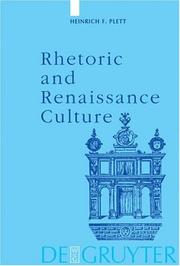| Listing 1 - 10 of 38 | << page >> |
Sort by
|
Book
ISBN: 9780199597284 0199597286 9780199679997 0199679991 0191619043 0191804584 Year: 2011 Volume: *18 Publisher: Oxford [etc.] Oxford University Press
Abstract | Keywords | Export | Availability | Bookmark
 Loading...
Loading...Choose an application
- Reference Manager
- EndNote
- RefWorks (Direct export to RefWorks)
Describes the most important individual contributions to the development of Renaissance rhetoric and analyzes the new ideas which Renaissance thinkers contributed to rhetorical theory.
Literary rhetorics --- anno 1500-1799 --- anno 1400-1499 --- anno 1300-1399 --- Rhetoric, Renaissance --- History. --- Comparative literature --- Renaissance rhetoric --- History --- Rhétorique --- 1500-1800 --- Rhétorique
Book
ISBN: 0691647569 0691620849 1400870666 9781400870660 9780691620848 9780691051826 9780691647562 Year: 1970 Publisher: Princeton, New Jersey : Princeton University Press,
Abstract | Keywords | Export | Availability | Bookmark
 Loading...
Loading...Choose an application
- Reference Manager
- EndNote
- RefWorks (Direct export to RefWorks)
Annabel M. Patterson offers here a reassessment of the place of Hermogenes, a Greek rhetorician of the second century A.D., in literary history. She shows that the literary men of the European Renaissance-scholars, critics, and poets-found Hermogenes' Concerning Ideas both important and extremely useful, and she finds that they vigorously applied his concepts to create "a lovely conformitie."The author first gives the history of this treatise on style and a detailed critical analysis of the Seven Ideas or categories of style. The book then demonstrates genre by genre how knowledge of the Seven Ideas can improve one's understanding of poetic development, especially in England, and reveals how the Ideas operate in the works of Tasso, Donne, Sidney, Shakespeare, Marvell, Jonson, Spenser, Milton , and many other poets and critics.Originally published in 1970.The Princeton Legacy Library uses the latest print-on-demand technology to again make available previously out-of-print books from the distinguished backlist of Princeton University Press. These editions preserve the original texts of these important books while presenting them in durable paperback and hardcover editions. The goal of the Princeton Legacy Library is to vastly increase access to the rich scholarly heritage found in the thousands of books published by Princeton University Press since its founding in 1905.
Style, Literary. --- Rhetoric, Renaissance. --- European literature --- Literature --- Style, Literary --- Language and languages --- Rhetoric --- Renaissance rhetoric --- History and criticism --- Theory, etc. --- Style --- Hermogenes, --- Literary style.
Book
ISBN: 0691649227 1400878829 9781400878826 0691622442 9780691622446 0691051674 9780691649221 Year: 1968 Publisher: Princeton, New Jersey : Princeton University Press,
Abstract | Keywords | Export | Availability | Bookmark
 Loading...
Loading...Choose an application
- Reference Manager
- EndNote
- RefWorks (Direct export to RefWorks)
The combination of rhetoric and philosophy appeared in the ancient world through Cicero, and revived as an ideal in the Renaissance. By a careful and precise analysis of the views of four major humanists-Petrarch, Salutati, Bruni, and Valla-Professor Seigel seeks to establish that they were first of all professional rhetoricians, completely committed to the relation between philosophy and rhetoric. He then explores the broader problem of the "external history" of humanism, and reopens basic questions about Renaissance culture. He departs from the views held by such scholars as Hans Baron and Lauro Martines and expands the conclusions suggested by Paul Oskar Kristeller. The result is a stimulating, controversial study that rejects some of the claims made for the humanists and indicates achievements and limitations. Originally published in 1968.The Princeton Legacy Library uses the latest print-on-demand technology to again make available previously out-of-print books from the distinguished backlist of Princeton University Press. These editions preserve the original texts of these important books while presenting them in durable paperback and hardcover editions. The goal of the Princeton Legacy Library is to vastly increase access to the rich scholarly heritage found in the thousands of books published by Princeton University Press since its founding in 1905.
Humanism. --- Humanists. --- Philosophy, Renaissance. --- Rhetoric, Renaissance. --- PHILOSOPHY / Movements / Humanism. --- Renaissance rhetoric --- Philosophy, Modern --- Renaissance philosophy --- Scholars --- Philosophy --- Classical education --- Classical philology --- Philosophical anthropology --- Renaissance

ISBN: 0870234854 0585221146 9780585221144 9780870234859 1122051956 9781122051958 Year: 1986 Publisher: Amherst (Mass.): University of Massachusetts,
Abstract | Keywords | Export | Availability | Bookmark
 Loading...
Loading...Choose an application
- Reference Manager
- EndNote
- RefWorks (Direct export to RefWorks)
English fiction --- -Humanism in literature --- Humanists --- -Rhetoric, Renaissance --- Poetics --- -Renaissance rhetoric --- English literature --- Poetry --- Scholars --- History and criticism --- History --- -Technique --- England --- Intellectual life --- Rhetoric, Renaissance --- -English fiction --- Humanism in literature --- Renaissance rhetoric --- Poetics - History - 16th century --- Humanists - England --- English fiction - Early modern, 1500-1700 - History and criticism --- England - Intellectual life - 16th century

ISBN: 0520209370 0585105103 Year: 1997 Volume: 36 Publisher: Berkeley (Calif.) : University of California press,
Abstract | Keywords | Export | Availability | Bookmark
 Loading...
Loading...Choose an application
- Reference Manager
- EndNote
- RefWorks (Direct export to RefWorks)
Christian saints --- Rhetoric, Renaissance --- Christianity --- Religion --- Philosophy & Religion --- Biography --- Ignatius, --- #GBIB: jesuitica --- 271.5-4 --- -Rhetoric, Renaissance --- -Renaissance rhetoric --- Saints --- Canonization --- Jezuïeten: stichting; stichter; regels; statuten --- Ignatius of Loyola, Saint --- Biography. --- -Jezuïeten: stichting; stichter; regels; statuten --- 271.5-4 Jezuïeten: stichting; stichter; regels; statuten --- -271.5-4 Jezuïeten: stichting; stichter; regels; statuten --- Renaissance rhetoric
Book
ISBN: 0520025016 Year: 1974 Publisher: Berkeley University of California press
Abstract | Keywords | Export | Availability | Bookmark
 Loading...
Loading...Choose an application
- Reference Manager
- EndNote
- RefWorks (Direct export to RefWorks)
English poetry --- -Renaissance --- -Rhetoric, Renaissance --- Renaissance rhetoric --- Renaissance --- Revival of letters --- Civilization --- History, Modern --- Civilization, Medieval --- Civilization, Modern --- Humanism --- Middle Ages --- English literature --- History and criticism --- History --- Rhetoric, Renaissance. --- History and criticism. --- Rhetoric, Renaissance
Book
ISBN: 0801464579 0801464102 9780801464577 9780801449659 0801449650 9780801464102 1322505330 Year: 2012 Publisher: Ithaca, N.Y. : Cornell University Press,
Abstract | Keywords | Export | Availability | Bookmark
 Loading...
Loading...Choose an application
- Reference Manager
- EndNote
- RefWorks (Direct export to RefWorks)
A central feature of English Renaissance humanism was its reverence for classical Latin as the one true form of eloquent expression. Yet sixteenth-century writers increasingly came to believe that England needed an equally distinguished vernacular language to serve its burgeoning national community. Thus, one of the main cultural projects of Renaissance rhetoricians was that of producing a "common" vernacular eloquence, mindful of its classical origins yet self-consciously English in character. The process of vernacularization began during Henry VIII's reign and continued, with fits and starts, late into the seventeenth century. However, as Jenny C. Mann shows in Outlaw Rhetoric, this project was beset with problems and conflicts from the start.Outlaw Rhetoric examines the substantial and largely unexplored archive of vernacular rhetorical guides produced in England between 1500 and 1700. Writers of these guides drew on classical training as they translated Greek and Latin figures of speech into an everyday English that could serve the ends of literary and national invention. In the process, however, they confronted aspects of rhetoric that run counter to its civilizing impulse. For instance, Mann finds repeated references to Robin Hood, indicating an ongoing concern that vernacular rhetoric is "outlaw" to the classical tradition because it is common, popular, and ephemeral. As this book shows, however, such allusions hint at a growing acceptance of the nonclassical along with a new esteem for literary production that can be identified as native to England. Working across a range of genres, Mann demonstrates the effects of this tension between classical rhetoric and English outlawry in works by Spenser, Shakespeare, Sidney, Jonson, and Cavendish. In so doing she reveals the political stakes of the vernacular rhetorical project in the age of Shakespeare.
English language --- Rhetoric, Renaissance --- National characteristics, English, in literature. --- Figures of speech in literature. --- Eloquence in literature. --- English literature --- Renaissance rhetoric --- Germanic languages --- Rhetoric --- Handbooks, manuals, etc. --- Early works to 1800. --- History and criticism.

ISBN: 128219559X 9786612195594 3110201895 9783110201895 3110174618 9783110174618 9781282195592 Year: 2004 Publisher: Berlin ; New York : de Gruyter,
Abstract | Keywords | Export | Availability | Bookmark
 Loading...
Loading...Choose an application
- Reference Manager
- EndNote
- RefWorks (Direct export to RefWorks)
Der Band bietet eine kulturhistorische Darstellung der europäischen Renaissance mit dem Schwerpunkt von Poetik und Literatur unter den Aspekten Imagination/Inventio, Gattungstheorie/Dispositio, Stil/Elocutio, Architektur/Memoria sowie Darstellung/Actio. Shakespeares Werke dienen der exemplarischen Veranschaulichung der beschriebenen rhetorischen Phänomene. Besondere Aufmerksamkeit ist der Rhetorik von Malerei und Musik sowie der rhetorischen Kulturideologie gewidmet. Since Jacob Burckhardt's Kultur der Renaissance in Italien (1869) rhetoric as a significant cultural factor of the renaissance has largely been neglected. The present study seeks to remedy this deficit regarding the arts by concentrating on literary theory and its aspects of imagination (inventio), genre (dispositio of the genera), style (elocutio), mnemonic architecture (memoria) and representation (actio), with illustrative examples taken from Shakespeare's works, but also on the intermedial rhetoric of painting and music. Particular attention is given to the rhetorical ideology of the Renaissance.
European literature --- Rhetoric, Renaissance. --- Art, Renaissance --- Renaissance art --- Renaissance rhetoric --- History and criticism. --- Themes, motives. --- Rhetoric, Renaissance --- #KVHA:Retorica --- #KVHA:Retoriek --- Themes, motives --- History and criticism --- Literary rhetorics --- Comparative literature --- anno 1400-1499 --- anno 1500-1599
Book
ISBN: 0812208803 081224558X 1322513198 Year: 2014 Publisher: University of Pennsylvania Press
Abstract | Keywords | Export | Availability | Bookmark
 Loading...
Loading...Choose an application
- Reference Manager
- EndNote
- RefWorks (Direct export to RefWorks)
In the late sixteenth century, as England began to assert its integrity as a nation and English its merit as a literate tongue, vernacular writing took a turn for the eccentric. Authors such as John Lyly, Edmund Spenser, and Christopher Marlowe loudly announced their ambitions for the mother tongue—but the extremity of their stylistic innovations yielded texts that seemed hardly English at all. Critics likened Lyly's hyperembellished prose to a bejeweled "Indian," complained that Spenser had "writ no language," and mocked Marlowe's blank verse as a "Turkish" concoction of "big-sounding sentences" and "termes Italianate." In its most sophisticated literary guises, the much-vaunted common tongue suddenly appeared quite foreign. In Uncommon Tongues, Catherine Nicholson locates strangeness at the paradoxical heart of sixteenth-century vernacular culture. Torn between two rival conceptions of eloquence, savvy writers and teachers labored to reconcile their country's need for a consistent, accessible mother tongue with the expectation that poetic language depart from everyday speech. That struggle, waged by pedagogical theorists and rhetoricians as well as authors we now recognize as some of the most accomplished and significant in English literary history, produced works that made the vernacular's oddities, constraints, and defects synonymous with its virtues. Such willful eccentricity, Nicholson argues, came to be seen as both the essence and antithesis of English eloquence.
English literature --- Eloquence in literature. --- English language --- National characteristics, English, in literature. --- Rhetoric, Renaissance --- Renaissance rhetoric --- History and criticism. --- Style. --- Rhetoric. --- Lyly, John, --- Spenser, Edmund, --- Marlowe, Christopher, --- Germanic languages --- Cultural Studies. --- Literature. --- Medieval and Renaissance Studies.
Book
ISBN: 3484450177 9783484450172 Year: 1975 Volume: 18 Publisher: Tübingen: Niemeyer,
Abstract | Keywords | Export | Availability | Bookmark
 Loading...
Loading...Choose an application
- Reference Manager
- EndNote
- RefWorks (Direct export to RefWorks)
Aesthetics --- retoriek --- anno 1500-1599 --- Rhetoric, Renaissance --- Poetics --- Renaissance --- History --- 820-5 --- -Renaissance --- Renaissance rhetoric --- Revival of letters --- Civilization --- History, Modern --- Civilization, Medieval --- Civilization, Modern --- Humanism --- Middle Ages --- Poetry --- Engelse literatuur: redevoering; preek --- Technique --- Renaissance. --- Rhetoric, Renaissance. --- History. --- 820-5 Engelse literatuur: redevoering; preek --- Poetics - History
| Listing 1 - 10 of 38 | << page >> |
Sort by
|

 Search
Search Feedback
Feedback About UniCat
About UniCat  Help
Help News
News